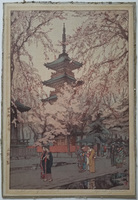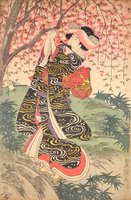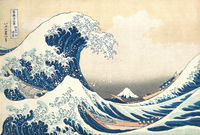Items
Tag
woodblock print
-
 "A Glimpse of Ueno Park"_Yoshida Hiroshi Following the Great Kanto Earthquake of 1923, Hiroshi Yoshida embarked on a tour of the United States and Europe, painting and selling his work. When he returned to Japan in 1925, he started his own workshop, specializing in landscapes inspired both by his native country and his travels abroad. Yoshida often worked through the entire process himself: designing the print, carving his own blocks, and printing his work. His career was temporarily interrupted by his sojourn as a war correspondent in Manchuria during the Pacific War. Although he designed his last print in 1946, Yoshida continued to paint with oils and watercolors up until his death in 1950. Hiroshi Yoshida was widely traveled and knowledgeable of Western aesthetics, yet maintained an allegiance to traditional Japanese techniques and traditions. Attracted by the calmer moments of nature, his woodblock prints breathe coolness, invite meditation, and set a soft, peaceful mood. All of his lifetime prints are signed “Hiroshi Yoshida” in pencil and marked with a jizuri (self-printed) seal outside of the margin. Within the image, most prints are signed “Yoshida” with brush and ink beside a red “Hiroshi” seal.
"A Glimpse of Ueno Park"_Yoshida Hiroshi Following the Great Kanto Earthquake of 1923, Hiroshi Yoshida embarked on a tour of the United States and Europe, painting and selling his work. When he returned to Japan in 1925, he started his own workshop, specializing in landscapes inspired both by his native country and his travels abroad. Yoshida often worked through the entire process himself: designing the print, carving his own blocks, and printing his work. His career was temporarily interrupted by his sojourn as a war correspondent in Manchuria during the Pacific War. Although he designed his last print in 1946, Yoshida continued to paint with oils and watercolors up until his death in 1950. Hiroshi Yoshida was widely traveled and knowledgeable of Western aesthetics, yet maintained an allegiance to traditional Japanese techniques and traditions. Attracted by the calmer moments of nature, his woodblock prints breathe coolness, invite meditation, and set a soft, peaceful mood. All of his lifetime prints are signed “Hiroshi Yoshida” in pencil and marked with a jizuri (self-printed) seal outside of the margin. Within the image, most prints are signed “Yoshida” with brush and ink beside a red “Hiroshi” seal. -
 "Springtime"_Toyokuni ga Ukiyo-e artist Utagawa Toyokuni catapulted the eponymous Utagawa School to fame with his prints of elegant courtesans and actors, book illustrations, and paintings. He had a strong reputation during his lifetime and taught a host of talented students who carried on the traditions of the Utagawa School, including Utagawa Kunisada and Kuniyoshi. Toyokuni drew inspiration from the famous contemporary artists around him, particularly from Kitagawa Utamaro. During the early 1790s, his output mainly consisted of portraits of courtesans, who bear an elegance and idealism indicative of the period. These works set a standard for bijin-ga (pictures of beautiful women) for Ukiyo-e artists for generations to come. Through the 1790s and 1800s, Toyokuni not only captured actors’ stage roles, but also their private lives and individual personalities in his yakusha-e (actor prints).
"Springtime"_Toyokuni ga Ukiyo-e artist Utagawa Toyokuni catapulted the eponymous Utagawa School to fame with his prints of elegant courtesans and actors, book illustrations, and paintings. He had a strong reputation during his lifetime and taught a host of talented students who carried on the traditions of the Utagawa School, including Utagawa Kunisada and Kuniyoshi. Toyokuni drew inspiration from the famous contemporary artists around him, particularly from Kitagawa Utamaro. During the early 1790s, his output mainly consisted of portraits of courtesans, who bear an elegance and idealism indicative of the period. These works set a standard for bijin-ga (pictures of beautiful women) for Ukiyo-e artists for generations to come. Through the 1790s and 1800s, Toyokuni not only captured actors’ stage roles, but also their private lives and individual personalities in his yakusha-e (actor prints). -
 The Great Wave The image depicts an enormous wave threatening three boats while Mount Fuji rises in the background. As in many of the prints in the series, it depicts the area around Mount Fuji under particular conditions, and the mountain itself appears in the background.
The Great Wave The image depicts an enormous wave threatening three boats while Mount Fuji rises in the background. As in many of the prints in the series, it depicts the area around Mount Fuji under particular conditions, and the mountain itself appears in the background.